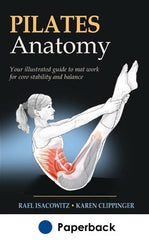Learn three ways to control breathing during Pilates
This is an excerpt from Pilates Anatomy by Rael Isacowitz & Karen Clippinger.
Breathing During the Practice of Pilates
The belief that breathing exercises, or voluntarily controlled breathing patterns, may provide health benefits or enhance physical performance has been shared by many cultures for centuries. The proposed benefits range from enhanced relaxation and decreased stress to lowered blood pressure, improved focus, activation of specific muscles, better circulation and respiration, and even lowered risk for cardiovascular disease. Although some scientific research exists regarding the potential positive effects of various controlled breathing techniques, additional research is needed to better understand these benefits and create optimal training techniques. However, one cannot ignore the number of disciplines, both Eastern and Western, that use breath in a profound way—yoga, tai chi, aikido, karate, capoeira, dance, swimming, weightlifting, and so on. Some systems of training have endeavored to harness different effects of breath to enhance performance or foster health of the body, mind, and spirit.
Pilates uses breathing in various ways in an attempt to foster these greater benefits. Three key ways that breathing is shaped, or controlled, in Pilates is through lateral breathing, set breath patterns, and active breathing.
Lateral Breathing
Lateral, or intercostal, breathing emphasizes the lateral expansion of the rib cage while maintaining a consistent inward pull of the deep abdominal muscles during both inhalation and exhalation. This is in contrast to the type of breathing that emphasizes the lowering of the diaphragm during inhalation (often called diaphragmatic breathing), with the abdominal muscles relaxed so they are allowed to push outward.
A reason for using lateral breathing is to help maintain abdominal contraction while performing Pilates exercises during which keeping a stable core is important for successful performance and for protection of the body. This by no means implies that diaphragmatic breathing is negative or that the diaphragm does not still play a vital role in breathing, only that lateral breathing is the preferred mode during the practice of Pilates.
Set Breath Patterns
Many Pilates exercises have a set breath pattern. An inhalation occurs during some phase of the movement, and an exhalation occurs during another phase. One reason for these patterns is to keep you from holding your breath, particularly when a lot of effort is required in an exercise. Holding the breath can be associated with excessive muscle tension and an undesired and potentially dangerous increase in blood pressure (the Valsalva maneuver). Exhaling during the phase that requires greater exertion can prevent holding the breath.
A given breath pattern may also influence the muscles being recruited. For example, an exhalation can foster activation of the deep abdominal muscle called the transversus abdominis.
Lastly, the breath pattern can help establish the dynamic, or rhythm, of a given Pilates exercise. Every exercise in Pilates has a particular quality. Some exercises or phases of a given exercise are performed more slowly and smoothly. Others are performed more rapidly and forcefully. The varying dynamics assist in giving a Pilates session variety as well as simulating daily activities more closely.
Active Breathing
A special case in which breathing may dramatically influence the dynamic of an exercise is active breathing. In signature exercises such as Hundred, the breath is pushed out not only more forcefully during exhalation but also with a percussive emphasis as the practitioner actively contracts the abdominals and particularly the internal intercostals in stages. On the inhale, the breath is drawn in with a percussive emphasis in stages, highlighting the external intercostals. Hundred, for example, requires five beats during inhalation and five beats during exhalation. Each beat represents further contraction of these muscles.
Use of active breathing should be individual. People who work with excessive tension are encouraged to use a more relaxed and softer mode of breathing. For some, active breathing may help activate target muscles and inject a higher energy into a Pilates session.
Ron Fletcher, an early student of Joseph and Clara Pilates and one of the foremost teachers of Pilates, developed an approach to breathing called Percussive Breathing. He explains: “The breath shapes the movement and defines its dynamic.” Percussive should not be mistaken for forceful; rather, it offers a sound and rhythm to the breath that fluctuates with each exercise. Think of it as inflating a balloon and then releasing as much air as possible through a small opening in a constant, steady stream. This concept is reminiscent of Joseph Pilates' breathometer, a spinning wheel that turned as one blew at it. The goal was to keep the wheel turning at a consistent velocity. “There needs to be intention to both the inhale and exhale,” Fletcher notes, recalling Joseph Pilates saying in his thick German accent, “You must out the air before you can in the air.” Fletcher adds, “Inspiration is inspiration for the movement.”
Read more about Pilates Anatomy.


Get the latest insights with regular newsletters, plus periodic product information and special insider offers.
JOIN NOW


